Profile: Alan Simpson
b. 1940
Alan Simpson was one of the most successful 1,500 runners during the 1960s. In his prime this fierce competitor rarely lost a race. He had an amazingly successful record in the two-a-side international competitions that were very popular at that time, winning 14 of his 17 races for his country. He set British records for 1,500, the Mile and 2,000, won the Mile British title three consecutive years (1963-65), and represented England in the International Cross-Country Championships. His best performance in major competitions was fourth in the 1964 Olympic 1,500; as well, though neither performance pleased him, he won a silver medal at the 1966 Commonwealth Games and placed fourth in the 1966 European 1,500.
Simpson worked full-time throughout his five–year international career. A strict amateur, he sometimes had to hitchhike the 240K from his home Rotherham to London to compete for his country. And his country kept selecting him. In many ways his success contributed to the shortness of his career as the rigours of a physical job, 80-miles-a-week training, constant traveling and top-class competition left him physically and mentally exhausted by the time he was 25. In 1965, the day before he won an international race in East Germany, he told Neil Allen of The Times, “I feel dead tired and a little fed up with competition.” (Sept. 4) Simpson continued competing at the top level for another two years, but his heart was no longer in it. In fact he has almost blocked out his last season (1967) from his memory.
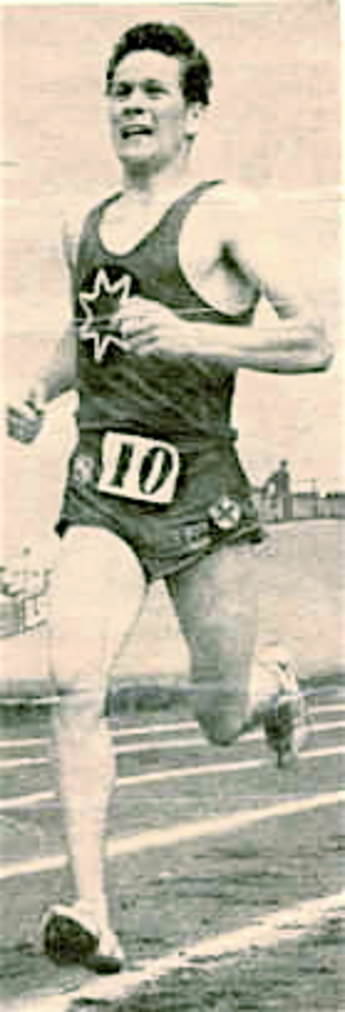 |
Perhaps the best way to appreciate the tenacity and finishing power of Alan Simpson is to watch the film of the 1964 Olympic 1,500 final. At the bell, his situation at the back of the pack looked desperate. His initial effort to move up to the front was frustrated by his team-mate John Whetton, who unknowingly forced Simpson really wide round the top bend. While this was happening Peter Snell took off, never to be caught.
The race was on for second place. Down the back straight, while all his rivals were sprinting in vain to catch Snell, Simpson moved up the field. By the time the pack hit the final straight he had passed everyone but Snell, who was a good 10 meters ahead. As he now admits, he was tying up badly. Nevertheless, he almost managed to hold on as the rest of the field made the dash to the tape. John Davies of New Zealand and Josef Odlozil of Poland came by, but he did not give up. And with a desperate dive that left him flat out on the cinder track he failed by only 1/10th of a second to win the silver medal. In the parlance of the running world, this was definitely an “eyeballs out” effort.
Early Days
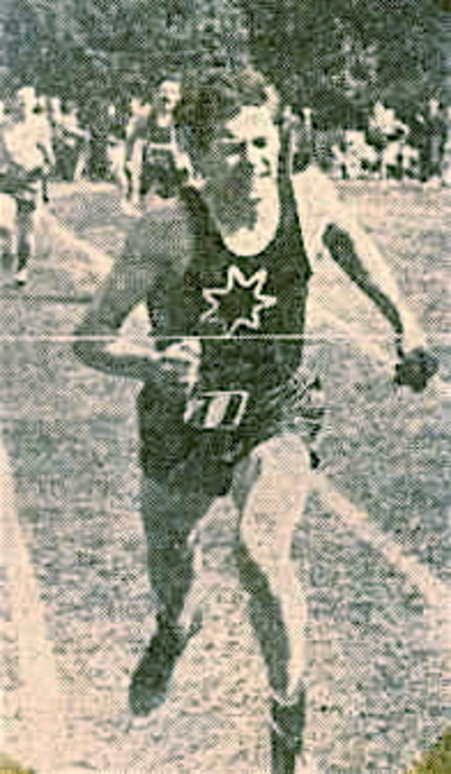 |
| An early photos shows Simpson already giving it all. |
Simpson’s running career began when he was 14: “One day, some fellow down in the village said, ‘I am going to take you down to Rotherham Harriers.’ From there, it all just happened. I went from boys to youths, juniors and seniors.” Leaving school at 15, he went to work in a local steel mill, working different shifts. To fit in his training, he began to run to and from work. His promise was first evident in cross-country. At 15 he won a Sheffield and District Boys Cross-Country title. The next two years he won the Youths race and placed 4th in the Youths Northern Championships. At the same time he was winning 880 races in the summer.
As his running grew in importance, he changed jobs: “With my running getting better, I didn’t want to be working shifts. So I got a job as a bricklayer’s labourer for the local council. When I started to get a few trips, I needed to work for someone who’d pay me while I was off work. Otherwise I wouldn’t be able to afford to go to any meetings.”
Through the winter of 1960-1 he was averaging 80 miles a week, and the hard work saw him improve steadily. In 1961 he ran second to Colin Robinson in the Junior International in Nantes. Then after winning the Yorkshire 880 and Mile (beating Ibbotson in the latter), he ran a fast 880 against Loughborough (1:51.6) and came to the notice of the national press. A fast relay leg in a 4xMile race in Dublin (4:05) earned him his first British vest for a B match against Switzerland. His win against Switzerland was the first of several more victories that season, the most notable being in international competitions with Poland and France. By this time he had gone back to work in the steel mill: “They looked after me. For any international meets I wouldn’t lose any pay.”
Setbacks
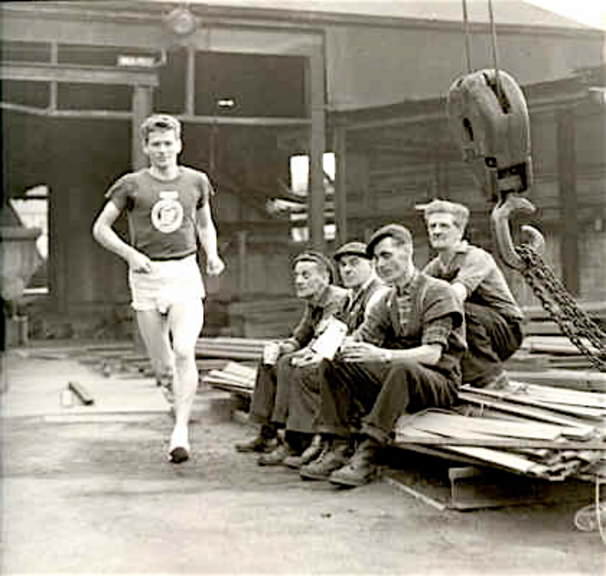 |
| Running home from work. |
But this convenient job didn’t last: “I used to have my dinner with this old chap in the mill. One day he said, ‘Have you noticed anything in the workshop?’ I said no. He said, ‘You’ve been sent to Coventry.’" [This is a practice whereby everyone refuses to associate with or talk to a particular person.] Why did this happen? “The guys in the shop didn’t like it that I was getting paid when I wasn’t there. So I went to see the pit-top manager. He said, ‘On Monday morning I want you to go down and see the groundsman. You’ll be working with him from now on.’”
Then injury ruined his 1962 track season. After a promising 24th in the Intercounties Cross-Country, he developed shin splints. He finally got back into shape at the end of the track season, running second to Michel Jazy in Paris (3:44.0) and qualifying for the Perth Commonwealth Games in December. His first experience of a major games was disappointing: “I ran terrible. Bruce Tulloh were a late entry. And I think he finished in front of me. Else I’d have qualified [for the final]. I was very naïve at this stage for the big occasion.”
Coaching
Up to this time, Simpson had been advised by one of his regular training partners, Peter Keeling. But when he started to win some big races, a coach was assigned to him: “One day the BAAB told me that the new coach for the north of England was coming to see me. Ian Ward. He took me over, writing my schedules. I used to see him about once a fortnight. When he was at my sessions, I was always faster.”
First National Title
Simpson took his Commonwealth fitness into the 1963 cross-country season, surprising many with his 9th in the National and a place on the England team. “The reason I was so far up—I think it were at Blackpool and it was very flat—was that [the course] suited track runners.” He performed well in the International race, finishing 45th and 7th England scorer. He then went on to win the AAA Mile in 4:04.9 and an international 1,500, beating the strong Finnish runner Salonen (3:43.2 to 3:43.4).
All was not well, however. In an August match against the USA, he dropped out of the Mile “without explanation.” (Times, Aug 6, 1963) : “I remember it well. It wasn’t so much the occasion as the people I was running against [O’Hara and Weisiger]. They psyched me out, or I psyched myself out.” This was the first indication of burn-out that he was to experience more dramatically in the years to come. He had been training and racing hard for a year without a break. “I got slated by the press,” he remembers, “so I cleared off on holiday. I went down to Torquay area with Bob and Pam Piercy. I got a race down there because I wanted to get it out of my system. The race was a 3/4 Mile, and I just blasted it.” The vacation did him some good because he came back to win two international 1,500s, beating Siegfried Valentin in the second one.
Olympic Year
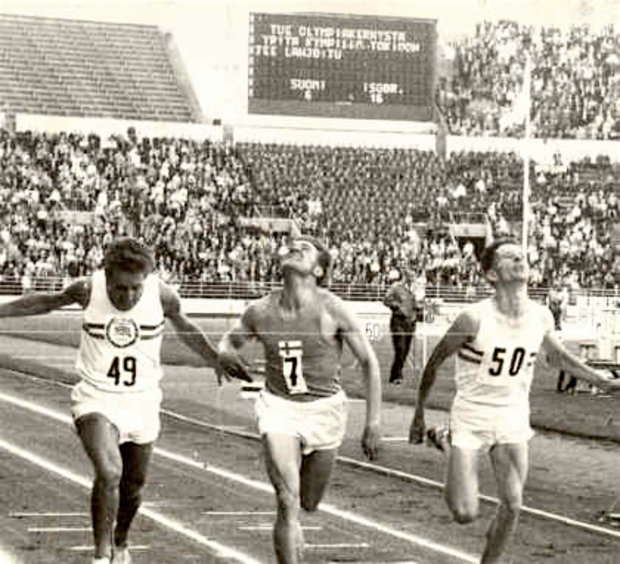 |
| Victory in Finland from Salonen and Whetton. |
His winter preparation for 1964 set him up for an impressive string of wins that was broken only in the Intercounties Mile, where McKim beat him into second place. He got close to 4:00 in the AAAs with a 4:01.1 victory over Mike Wiggs. Then he had a bad fall at the White City in August: “I think they went under 4:00 in that race, and I hadn’t been under 4:00 at that stage. That really peed me off.” To compensate for this disappointment, he ran a UK record of 3:39.1 for a big win over Poland’s Witold Baran and was selected for the Olympics. This was followed by a win over Wadoux of France (3:44.7) and a surprising Three Miles victory over Ibbotson and Tulloh with a 13:31.2 PB.
Tokyo
Despite being in the form of his life, Simpson went to Tokyo with modest expectations: “First and foremost you just want to make the Olympic team. I had run a new British record, so I thought I’d make it. But you are never sure until the letter arrives. And then you think, yeh, if I make the semis I’ve done well. I actually cruised through my heat and semi without much trouble.” For the final, Snell looked in a class of his own, but the other two medals looked to be up for grabs. One of Simpson’s big rivals was Odlozil, who had run a fast 3:39.3 to qualify for the final: “We were quite buddies really. I went to see him just before the Olympic final in his dressing room right next door. He pointed at me and said, ‘You should get a medal today.’”
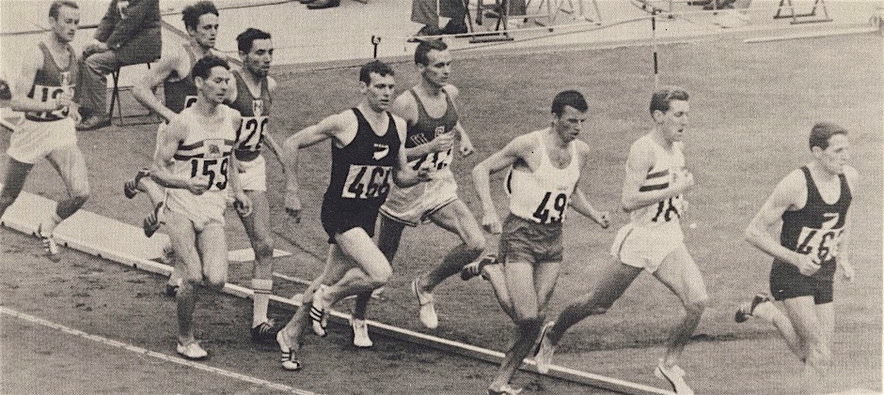 |
| Simpson (159) in the pack while Davies leads. |
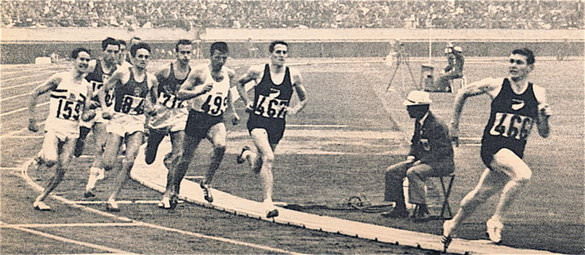 |
| 300 to go: Simpson reacts early to Snell's attack. |
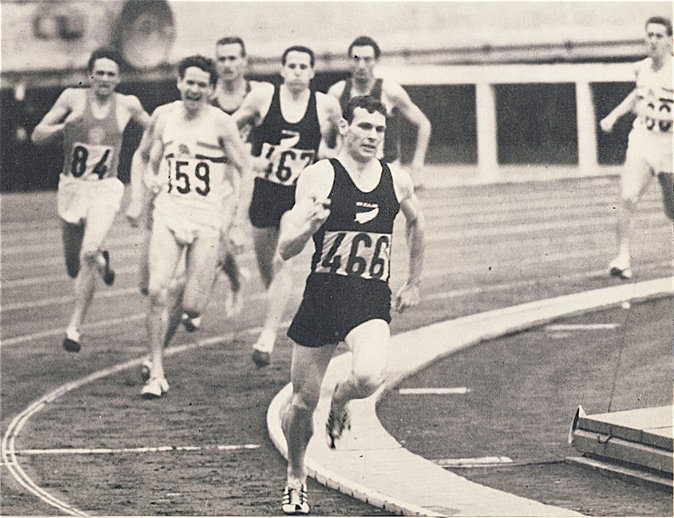 |
| Entering the final straight: Simpson is nowin second |
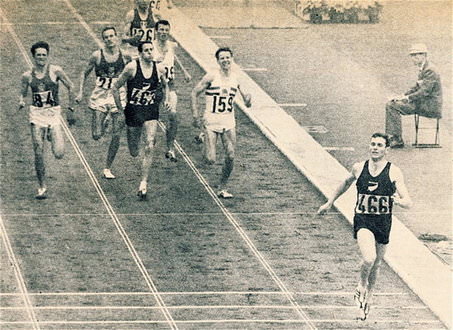 |
| The great battle for second as Odlozil and Davies draw level with Simpson. |
The early pace was set by Bernard of France. Davies of New Zealand then took the lead at 700 and was still leading with 300 to go. Behind him, Snell in third was ready to pounce. Simpson had run comfortably in the pack, but he drifted back to 8th when the pace picked up between 1100 and 1200. This left him with a lot of work to do in the last 300: “Because I had come out of the pack I went round the top bend in about the fourth lane. I was up with the group and all of a sudden I saw Snell clear off. So I came out of the pack, and I had to push and push.” His speed down the back straight was matched only by Snell, who by this time was well ahead. And as he came into the straight, luckily finding an inside gap, he was suddenly second. Thus in 200m, when everyone was sprinting flat out, he had moved up six places. But the effort left him tying up badly, and Davies and Odlozil managed to just get by and hold on by only 1/10th of a second. Simpson made a desperate dive at the tape—to no avail.
In retrospect, Simpson felt he had done too much between 1200 and 1400: “I think if I had waited and waited, I could have got something with my kick. I should have been able to get a better position.” Still, fourth place in an Olympic final was a fine achievement. “Everybody said I’d run really well,” Simpson recalled. Neil Allen wrote that Simpson “ran a race of great courage” and called his fourth place “a personal triumph.” (Times, Oct.22, 1964)
1965: His Best Year
1964 had been a good year, but Simpson reckons that 1965 was his best. After running a world best time indoors for 5,000 in 13:58.4, he finally broke the 4-minute barrier with 3:56.6 in the Intercounties Mile. Unusually for a sitter, he took over the lead after two laps (1:59.4) and pushed himself all the way with 60.4 and 56.8 laps. “I was quite pleased with that, he says. “I got one of the lads to take me through a couple of laps. It was no harder than any of my other races.”
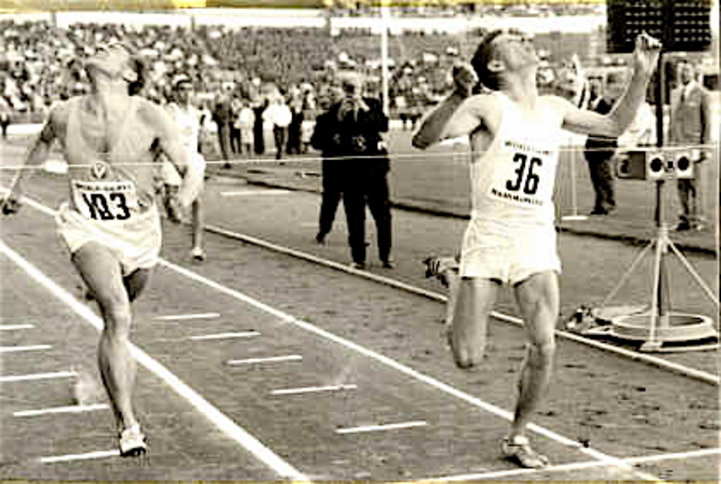 |
| Yet another international win to beat Poland's Baran. |
His winning ways continued in the AAA Championships (4:01.9). This was his third consecutive win in this event. Then he won a big Mile invitational in Dublin with 3:56.9, this time beating Peter Snell. Modestly he claims that “I think he were tapering off. I don’t know if he had stopped training and were just touring.” Still, Simpson showed confidence in his strength by making his effort early from 500 yards out. He passed the bell in 3:00.5 and held on for an impressive win. It was an unusual tactic for him, one that he might have used more often. After winning an 880 in the Welsh Games (1:49.5), he beat his old rival Baran in an international against Poland (3:43.1 to 3:43.3). And then in the Emsley Carr Mile he beat Odlozil and Grelle with a 4:04.1. It would be fair to say that Simpson looked unbeatable at this point in the season.
He was still running well at the end of August, and in the Morley Mile he broke his British record with 3:55.7. But this time he didn’t win. The amazing Kenyan Kip Keino, who had first appeared on the scene in the Tokyo Olympics, took the race in 3:54.2, and Odlozil just managed to finish ahead of Simpson in 3:55.6. In view of his two earlier races when he had made a long run for home, this looked like the perfect race for Simpson to go for broke and stay with Keino when he passed the bell in 2:58.2. But the long season was beginning to take its toll. A few days later, he told the press that he was “dead tired” and “a little fed up with competition.” (Times, Sept.4, 1965)
But the British Board still wanted him to race. He won an international 1,500 against East Germany (3:44.8) and then ran a “reasonable” fourth in the Europe Cup behind Tummler, Wadoux and May (3:48.4). But Simpson had had enough and declined to represent his country in a match against West Germany.
Beginning of the End
By 1966 his enjoyment of running was waning: “I was starting to get that feeling at the end of 1965. It was the stress of competition. When I had a ten mile run or a track session or a race, I began to think, ‘I don’t want to do this anymore.’” What had been the cause of this burn-out? “It was competition and traveling and never being at home. Living out of hotels and suitcases. And many, many races.” There was also pressure away from the track: “People don’t realize it. You’re not running for yourself, you’re running for half the town you live in. When you’ve run a bad race, people you bump into will look the other way. And when you’ve run a good race, they want to come across and shake your hand.”
Nevertheless, Simpson wasn’t ready for retirement. “I just kept going,” he recalls. He had no big goals for 1966, despite the fact that the European and Commonwealth Games were scheduled: “I did run the Commonwealth, but I didn’t want to run. I were last at one stage.” He also ran in the European 1,500, but his heart wasn’t in that race either.
His year had begun quite well in the circumstances. He ran a fast third in an indoor Mile in San Francisco behind Ryun and Whetton. And he also ran a couple of quick indoor Two Miles in 8:45 and 8:41. And in the early track season he won the British Games Mile in 3:58.4. But he was only 3rd in the AAAs Mile and then dropped out of a Two Miles at Crystal Palace. Neil Allen, reporting on this race, wrote that Simpson had “lost his flair.” (July 25) It was not an auspicious pre-Commonwealth-Games performance.
Commonwealth and European
The Mile in the Jamaica Commonwealth Games was another triumph for Kip Keino, who led for the whole race. Simpson, despite his fatigue, ran really well. He was close to Keino at 880 (1:58.7), but had no answer to the Kenyan’s third 57.9 lap. Worried about Simpson’s famous kick, Keino wanted to be well clear in the last lap. He said after, “All the time I was worrying about Simpson, though I believe I would have found a little extra if he had come up to my shoulder.” (Times, Aug 15,1966) In retrospect, Simpson knows that he should have stuck with Keino on that fast third lap: “He was very good, but I shouldn’t have been fazed as much as I was. I look back on my career and think that I needed somebody, maybe my coach Ian Ward, to say, ‘When Keino clears off on that third lap, go with him. You’ve got to do it.’ That’s what I needed—somebody to tell me. I were strong enough to do it. Keino used to falter on the last lap.”
Despite his mental fatigue, Simpson’s many years of hard training still enabled him to run some more fast times. In August he ran two sub-4s in 24 hours, finishing third in the Emsley Carr Mile behind Keino and Graham and then going down to Brighton the next day for another Mile race.
In the European 1,500 he was again in the hunt but ended up in fourth place behind three very good runners: Tümmler, Jazy and Norpoth. But he did get past Jurgen May in the run-in. With 12 runners in the final, there was a lot of jostling, and Simpson got boxed in at a crucial point in the race. Neil Allen astutely noticed “a lack of conviction” in Simpson’s performance. (Times, Sept.2, 1966)
One More Year
Simpson still wasn’t finished. He came back in 1967 to win the Intercounties Mile in 4:02.8 from Whetton. But he wasn’t up to challenging Ryun and Keino in a match between the Commonwealth and USA. He finished a distant third behind Ryun (3:33.1) and Keino (3:37.2) in 3:41.7. Still, the British selectors (BAAB) kept asking Simpson to compete, “When you got a letter from the British Board saying they want you to run against France, Germany or whatever, you did it,” Simpson admits ruefully. So he still kept performing for his country: a first place against France (3:45.6) and a first place against West Germany (3:42.5). There was quite a fuss when he asked to be left out of the team for a match against Hungary: “It is almost unprecedented for a British international to take Simpson’s attitude,” wrote Neil Allen (Times, July, 19,1967)
His career was just about over. One of his last international races was in Nairobi against Kip Keino. Keino won the race, but Simpson was able to record his last 4-minute mile with a 3:57.6. After his retirement from amateur athletics, he tried his hand at professional running.After a few months in Australia with the Victoria League, he went up to Scotland: “I went up there with Arthur Rowe, the shot putter. There were lots of meetings, but the money were terrible. The tracks had long grass and sometimes they had to move the sheep off first.”
Soon after this, he got a job at the new Rotherham Sports Centre. Starting as a chargehand, he later moved into management. He spent 23 years working there and for the last five was the Stadium Manager.
Retrospect
At age 72, Simpson can put his career in perspective: “Would I do it all again? I think so, yes. It’s another life. I suppose I got a chance to see the world. Like I said to you, I would have liked not to have sat in so many races. I’d have liked to be versatile and took it with three laps to go.”
Simpson is struck by the big changes in athletics: "There was no sponsorship at all in my day. Now they have pacemakers earning 20,000 pounds and 50,000 if you break the record. We used to run against each other. Tactical.” Did he worry much about his times? “No, I was quite happy to win. But I were very happy to run under four.” So he didn’t feel the pressure to satisfy thee crowds with fast times? “No, not at the time. I could win by racing well over the last 150. I could accelerate away. Looking back, I should have took some of the races from the start and pushed on. I could have probably run faster than I did.” 
Personal Bests: 880 1:49.5; 1,500 3:39.1; Mile 3:55.7; 2,000 5:08.0; 3,000 8:09.8; 2 Miles 8:43.0; 3 Miles 13:30.4; 6 Miles 29:27.0.
Note: All unattributed quotations are from a personal telephone interview conducted on May 10, 2012.
17 Comments